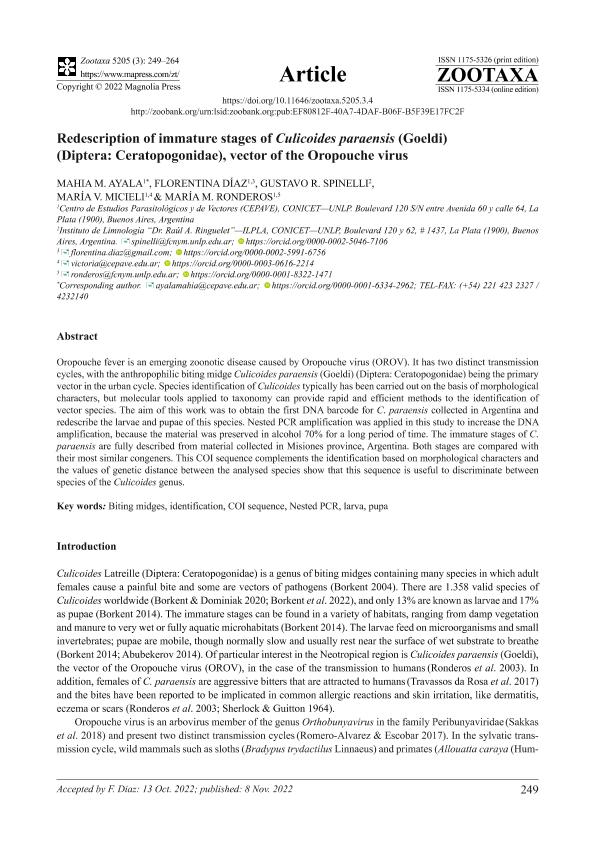Artículo
Redescription of immature stages of Culicoides paraensis (Goeldi) (Diptera: Ceratopogonidae), vector of the Oropouche virus
Ayala, Mahia Mariel ; Diaz, Maria Florentina
; Diaz, Maria Florentina ; Spinelli, Gustavo Ricardo
; Spinelli, Gustavo Ricardo ; Micieli, Maria Victoria
; Micieli, Maria Victoria ; Ronderos, Maria Marcela
; Ronderos, Maria Marcela
 ; Diaz, Maria Florentina
; Diaz, Maria Florentina ; Spinelli, Gustavo Ricardo
; Spinelli, Gustavo Ricardo ; Micieli, Maria Victoria
; Micieli, Maria Victoria ; Ronderos, Maria Marcela
; Ronderos, Maria Marcela
Fecha de publicación:
11/2022
Editorial:
Magnolia Press
Revista:
Zootaxa
ISSN:
1175-5326
Idioma:
Inglés
Tipo de recurso:
Artículo publicado
Clasificación temática:
Resumen
Oropouche fever is an emerging zoonotic disease caused by Oropouche virus (OROV). It has two distinct transmission cycles, with the anthropophilic biting midge Culicoides paraensis (Goeldi) (Diptera: Ceratopogonidae) being the primary vector in the urban cycle. Species identification of Culicoides typically has been carried out on the basis of morphological characters, but molecular tools applied to taxonomy can provide rapid and efficient methods to the identification of vector species. The aim of this work was to obtain the first DNA barcode for C. paraensis collected in Argentina and redescribe the larvae and pupae of this species. Nested PCR amplification was applied in this study to increase the DNA amplification, because the material was preserved in alcohol 70% for a long period of time. The immature stages of C. paraensis are fully described from material collected in Misiones province, Argentina. Both stages are compared with their most similar congeners. This COI sequence complements the identification based on morphological characters and the values of genetic distance between the analysed species show that this sequence is useful to discriminate between species of the Culicoides genus.
Palabras clave:
BITING MIDGES
,
COI SEQUENCE
,
IDENTIFICATION
,
LARVA
,
NESTED PCR
,
PUPA
Archivos asociados
Licencia
Identificadores
Colecciones
Articulos(CEPAVE)
Articulos de CENTRO DE EST.PARASITOL.Y DE VECTORES (I)
Articulos de CENTRO DE EST.PARASITOL.Y DE VECTORES (I)
Citación
Ayala, Mahia Mariel; Diaz, Maria Florentina; Spinelli, Gustavo Ricardo; Micieli, Maria Victoria; Ronderos, Maria Marcela; Redescription of immature stages of Culicoides paraensis (Goeldi) (Diptera: Ceratopogonidae), vector of the Oropouche virus; Magnolia Press; Zootaxa; 5205; 3; 11-2022; 249-264
Compartir
Altmétricas



